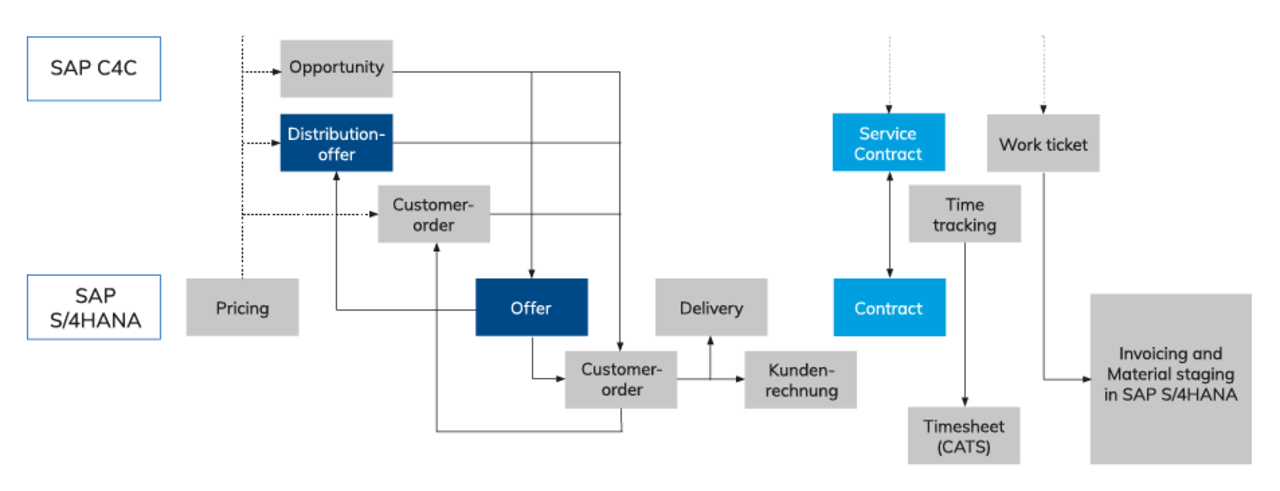When is the right time to switch to SAP CX Suite products?
This is a question that is on the minds of just about all of our customers and prospects, but one that cannot be answered in a blanket manner without further ado. SAP has announced that it will discontinue free support for SAP CRM until 2027. Optionally, support can be extended for three years until 2030 at a charge. A changeover from the "old" CRM world to a "new" one is therefore inevitable. The "new" alternatives to the "old" CRM are S/4HANA Service, as well as the products of the SAP CX Suite. These have already been presented to
you in the blog post by Jürgen Flakowski.
Switch to SAP Sales/SAP Service Cloud
Anyone who now wants to use the SAP CX Suite products to stay one step ahead of the competition in terms of analytics functions, simplicity of interfaces, mobility, etc. is bound to ask themselves when is the right time to make the switch. Our focus here is on the SAP Sales and Service Cloud solutions. Both are available with a respective enterprise version in a bundle as Cloud for Customer (C4C). The C4C can be used as a standalone variant as well as a front office solution with an integrated S/4HANA as a back office.
When does it make sense to switch to SAP Sales/Service Cloud in a standalone approach?
This approach is generally recommended if, for example, no CRM module and no S/4HANA is yet in use. And the sooner, the better. You start with a lean variant that is close to the standard in order to limit yourself to the essentials. Gradually, more functions can be added. SAP's roadmap for Sales and Service Cloud is designed to be comprehensive enough to allow users' understanding of the system and the maturity of the system and processes to grow organically. A standalone rollout of Sales and/or Service Cloud is also manageable in time, at 4 to 8 weeks. One reason for this is the lean and tidy interface, which is kept in the familiar Fiori design. Since the functions of the C4C are individually customizable, they can also be added gradually. This keeps the training effort for key users within limits. These points mean that understanding of the system and processes is high, while the potential frustration level of key users is extremely low.
Switching to a hybrid approach
We recommend a hybrid approach with SAP S/4HANA as the back office and a sales and/or service cloud as the front office solution. For more on this topic, see the blog post by Thomas Prekel. One of the main advantages of moving from SAP CRM to SAP S/4HANA Service is that the Service module has been transferred to the S/4HANA Core, eliminating the need for an interface to the ERP, which greatly simplifies the integration and migration process. In addition, the CX solutions integrate very well with S/4HANA. With this approach, customer centricity is mapped in the front-office solution (SAP CX), while the business processes (billing, etc.) are mapped in the back end.
Incidentally, the hybrid approach is also SAP's recommended system landscape.
When does it make sense to switch to a hybrid approach?
Basically, a distinction must be made here as to whether an S/4HANA system already exists or not. If the basis with an existing S/4 is available, the S/4HANA service from release 1901 is also already available in the core. In this case, the time to set up the Cloud for Customer as a front office solution is only marginally extended due to the integration. However, since this can be implemented seamlessly - both on-premise and in the S/4HANA Cloud - the immediate migration or the immediate addition of the C4C is also recommended in this approach.
Accordingly, migration is another time factor here. With a connected C4C, the focus on the customer can then be additionally gained and all the advantages of the new CRM world can be optimally exploited.
In the event that migration to S/4HANA has not yet taken place, it is also recommended here to implement this as quickly as possible. SAP estimates that it will take 12 to 18 months to migrate to S/4HANA, whereas support for ERP 6.0 will expire in 2027 or 2030 at the latest. This tight timeline alone makes it advisable to make the switch as early as possible.




